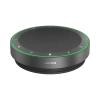
Published on 2015-03-05
Fujitsu today announced that it has developed an iris authentication system and has built it into a prototype smartphone. Just by looking at the smartphone’s screen, the user’s iris gets read instantaneously, enabling the smartphone to be unlocked.
Currently, smartphones typically use either a password or fingerprint scan to unlock the screen or for other authentication purposes. Fujitsu’s new authentication method uses iris recognition, which is hard to forge and convenient to use. The screen can be unlocked simply by looking at it, which eliminates the trouble of having to use one’s hands such as at times when one is wearing gloves and cannot use one’s fingerprint. This results in a dramatic improvement in usability. In addition to unlocking smartphones, iris authentication could be used to log into web services without having to input an ID or password, enabling simple and secure access. Fujitsu will explore applying this technology to a wide range of fields, including security systems.
This prototype will be exhibited and demonstrated at Mobile World Congress 2015, running from March 2 through March 5 in Barcelona, at the Fujitsu booth in Hall 5, 5A40.
Background
Smartphones and tablets carry not only personally significant photos and videos, they also are where people access electronic money and personal information, and the importance of security for both personal and business is rising. In light of this, Fujitsu has focused on developing a number of authentication technologies for smartphones, tablets, and computers, including vein authentication for personal computers and fingerprint authentication for mobile phones. While smartphones all come with some form of security as a standard feature today, many users choose not to use these features because of the trouble of inputting a password or using one’s hands. To resolve this problem, Fujitsu developed the new iris authentication system, which, in addition to being secure, offers ease of use.
A new form of biometric authentication using the iris
Iris authentication is one type of biometric authentication. It authenticates a person by authenticating the pattern of the person’s iris, which is the ring around the pupil of the eye. Fujitsu has succeeded in miniaturizing and optimizing existing iris authentication technology for incorporation into a smartphone. The pattern of one’s iris does not change much at all after the age of two, it is difficult to injure its surface, and is difficult to forge.
Using infrared light to acquire the iris pattern, and for registration and verification
Movements of the smooth muscle of the iris make human eye openings larger or smaller, adjusting the amount of light that enters the retina. Iris authentication technology discerns a person’s identity using the pattern of the person’s irises, which are unique for each individual, much like a fingerprint. That pattern is read by shining an infrared LED light (*1) on the eyes and taking an image of them with an infrared camera (*2) to acquire the iris pattern, which is registered and used to verify matches. The iris authentication system that Fujitsu has developed achieves highly precise authentication and is able to be used in smart devices for greater convenience.
Fujitsu’s Iris Authentication System
The parts that make up existing iris authentication systems have not had the size or performance that would lend them to use in smartphones. Fujitsu developed a custom compact and high-output infrared LED, and a custom infrared camera. These were combined with camera controller technology and biometric-authentication technology that Fujitsu has been developing for many years. The result is a system that can reliably authenticate the detailed patterns of the iris and that can be used in most everyday situations. Because this uses ActiveIRIS® from Delta ID, a high-speed, high-reliability iris recognition engine, this system can be used at a normal smartphone viewing distance, rather than within the 10-cm range that most existing iris recognition systems require. In standard photobiological safety testing (IEC 62471), the infrared LED light was verified to be safe for the eyes.
Future Development
The iris authentication system used in the prototype could be used in smartphones and tablets, of course, but could also be used in a wide range of other applications, including security solutions. Fujitsu is conducting ongoing research and development on this iris authentication technology and ways to broaden its scope, with the goal of a commercial implementation during fiscal 2015.
Glossary and Notes
1. Infrared LED: An LED that emits light in a waveband appropriate for capturing an image of the iris.
2. Infrared camera: Unlike normal photographic cameras, this is a special kind of camera that captures the waveband of light emitted by an infrared LED.
COMMENTS
No customer comments for the moment.